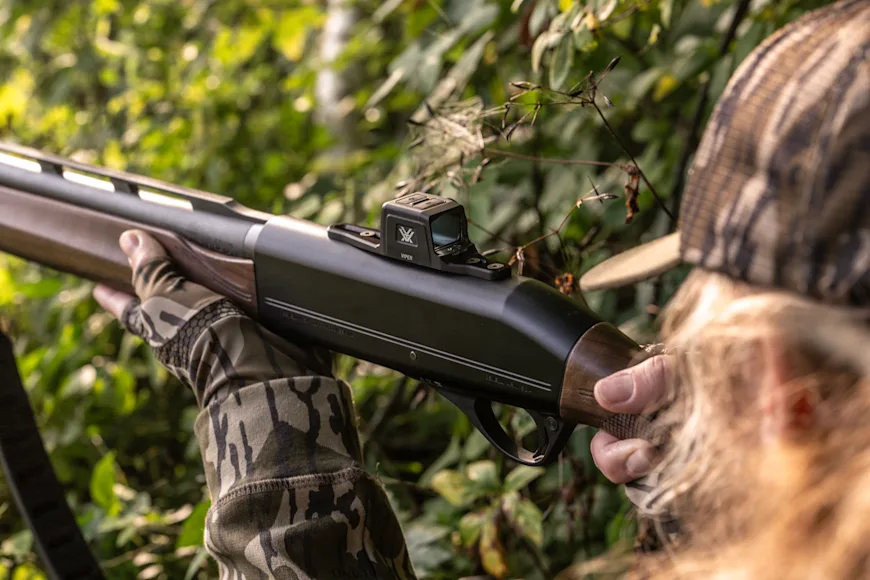If you buy into turkey chokes and expensive, tight-shooting turkey loads, your gun needs a sight. Period. Otherwise, you will whistle dense, tiny, grapefruit-size patterns right past the heads of turkeys, leaving them unharmed. Ask me how I know.
One good solution is to mount a red dot, and the most elegant red dot mounting solution on the market is the new Vortex Viper Shotgun Enclosed Red Dot. Combining a sight with a mount that fits at least 13 different popular shotgun brands, it removes the headache of finding a mount that fits both your gun and the sight you plan to use. It also puts the sight low to the bore so you can maintain good cheek contact with the stock. I've had the chance to test one at the range all spring. Here's my full review.
Vortex Viper Overview
Specs
Weight: 2.14 ounces
Reticle: 3 MOA, 32 MOA circle, 65 MOA circle
Adjustment: 10 daylight, 2 night-vision brightness settings
Battery Life: 50,000 hours
Battery: CR 2032
MSRP$299 (3 MOA reticle); $349 (multi reticle)
Pros
Mounts low to the bore of most popular drilled/tapped shotgun models
Enclosed-emitter design is durable and keeps mud and water out
50,000 hour battery life plus auto shutoff/motion activation
Cons
Brightness/dimness controls are harder to use than some others
The Viper comes in two versions: one with a 3 MOA dot, and one with a choice of a 3 MOA dot or a 32- or 65-MOA circle reticle. As much as I was initially excited about red-dot circle reticles for turkey hunting, I tried them (with other sights) and found that a simple dot that you can place on a turkey’s caruncles is the way to go. The circles are distracting. The sight has 10 daytime brightness settings, which you can adjust via rubberized buttons on the top. When I tried adjusting brightness with the gun mounted, as sometimes you do in the woods, they were hard to find and press without looking at them. Adjusting the brightness while wearing gloves was also hard. That’s not a deal-breaker, but it’s the one thing about this sight I didn’t like.
On the plus side, the sight boasts 50,000 hours of battery life (over five years) and an auto shutoff feature that turns it off if it hasn’t moved for ten minutes, and turns it back on when the sight does move. I tried, but could not outrace the motion activation. If the sight has gone to sleep and I move the gun, the dot is on before the gun is fully mounted. The upshot is this sight will run practically forever even if you forget to turn it off. If, by chance, you do need to change the battery, you unscrew a cap on the side of the housing and drop in a new CR2032 battery, so there is no need to remove the sight to make the switch.

Of course, you can mount any red dot to a Picatinny rail if your gun is drilled and tapped, but then you’ve added the height of the rail and the sight’s base. With most guns, that leaves you craning your neck and raising your head way off the comb to use the dot. By adding a pair of mounting feet to the body of the sight, Vortex solves the problem. The rear foot contains a screw-hole and short channel for a second screw. The front has a long channel, allowing you to put screws wherever there might be holes for them in the receiver. So long as your gun is tapped and the top of the receiver is flat, chances are very good this sight will fit. And, because the feet are extensions of the sight, it sits very low on the gun.
The sight itself is a closed-emitter red dot, which is a compact, durable design. I have clogged an open emitter sight with mud and broken the filament trying to clean that mud out. That experience taught me to appreciate the durability of a red dot in which everything is enclosed.
Like almost all red dots, this one does have a slight blue-ish tint when you look through it, which can be a problem first thing in the morning. I have seen worse in costlier sights, though, and that tint is one of the few downsides of using a red dot.

Installation and Testing
Installation was simple. Vortex includes four different screw sizes to fit various drilled/tapped holes. You look up the right size screw on the handy QR-code chart, and you’re off. The rear screw hole is the one that prevents the sight from moving forwards and backwards. The front screws help with that, too, but mostly they prevent the sight from moving side to side. I put mine on a Winchester SXP Long Beard, tightening them down to 12 pounds with a torque wrench per the instructions, and that was it. Installation could not have been easier.
The Viper withstood a good deal of recoil as I sighted it in and patterned several different loads through it. By the way, the sight gives you maximum elevation and windage adjustments of 100 MOA, which should be enough to get you on target. The screws were just as tight after a few shooting sessions as they were when I installed the Viper in the first place.
I have every confidence that if luck puts a turkey or two in front of this sight during the season, it will send a load of shot exactly where it’s aimed. I still have to aim in the right place, and that’s a lot easier to do with a sight that sits down low over the bore like the Vortex Viper Shotgun Enclosed Red Dot.



